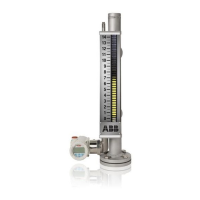21
KM26 | MAGNETIC LEVEL GAUGE | OI/KM26-EN REV I
• magnetic particles in the process fluid have become
attached to the float changing its buoyancy. Install
magnet traps in the process connection lines, then clean
and reinstall float.
• solidification of process fluids on the surface of the float
have changed its buoyancy. Consider replacing with a
Teflon® (registered trademark of DuPont) ‘S’ coated float,
heat tracing the chamber to decrease solidification, or
reduce the amount of solidifying particles in the
chamber.
• solidification of process fluid on the interior of the
chamber has decreased the clearance for the float.
Consider replacing with a coated chamber, heat tracing
the chamber to decrease solidification, or reduce the
amount of solidifying particles in the chamber.
Switch does not work
• switch installed upside down. Remove and install
correctly.
• float does not travel past the switch during operation.
Float may encounter float stop prior to activating switch.
Switch point should be a minimum of 1 in. inside the
upper and lower stop points for the float.
• contacts damaged due to excessive load, inductive load,
or dead short in the circuit. Replace the switch.
• magnet has been demagnetized by proximity to
magnetic source or ferrous materials. Replace the switch
and remove the interference. (continued on next page)
• distance between the switch and float is too large. Strap
may be loose, insulation may be too thick, attachment to
a switch mount rod may have moved or the switch has
been moved away from the location of a guided float.
• float has become demagnetized and indicator also
decouples readily. Have the float re-magnetized at the
factory and remove the source of demagnetizing.
5 Service and maintenance
Pre-startup
• If equipment is used in a manner not specified by ABB,
protection provided by equipment may be impaired.
• Manually move the float from 0% to 100% and back to 0%
prior to startup/check out in order to reinitialize any
switch accessories (only required if magnetically
actuated switches are supplied). Switches may
inadvertently change state during any rough handling
during transport.
• Remove float prior to pressurizing tank / vessel.
• Verify the MLGs center-to-center dimension equals that
of the tank / vessel.
4 Troubleshooting
Indicator decoupling
Causes:
• float is upside down. Remove, check field strength of
magnets, and install correctly. Proximity to opposing field
may weaken magnetic field.
• scale assembly is not flat against the chamber due to
missing straps. Magnetic field strength drops
exponentially with distance. Add gear clamps to eliminate
channel separation from chamber. Add stainless steel
retaining wires to eliminate indicator tube separation
from channel.
• float stop springs have been bent or broken. Adjust or
replace springs as needed to prevent float travel outside
the range of the indicator tube.
• scale has been moved allowing float travel outside of
range or causing too much separation from the float.
Reposition the scale.
• float or indicator de-magnetizing by proximity to other
magnetic material, high temperature, or repulsive fields.
Consult factory for re-magnetization of float or replace
the float and / or indicator and remove the source of
demagnetization. Sources include floats and switches
installed upside down, close ferrous materials, nearby
magnetic fields, magnetic particles from process piping,
etc.
• indicator tube is no longer sealed and contains moisture
or dirt. This increases friction inside the tube. Replace the
tube.
• chamber is not vertically level causing increased friction
between the shuttle and glass and increased distance
between the float and the scale assembly. Adjust the
position of the chamber.
• indicator tube incorrectly installed. See directions for
installation.
• magnetic particles from the process fluid stuck to float.
This distorts the magnetic field and changes the float
buoyancy. Remove and clean float and install magnetic
traps in the process connections.
If for some reason, magnetic coupling is lost, it can be
restored by following three simple steps.
1 Using a permanent magnet, locate the float inside the
chamber.
2 Take the permanent magnet and raise the follower to the
same level as the float.
3 Remove the magnet to the side as quickly as possible to
set the follower in a spinning motion.
Float sinks or sticks
• process specific gravity is lower than was specified at the
time of order. Identify true minimum specific gravity
requirements considering temperature and pressure
variations and order new float providing minimum and
operating specific gravity.
Float damage may occur if not removed prior to any
pressure testing.
CAUT ION

